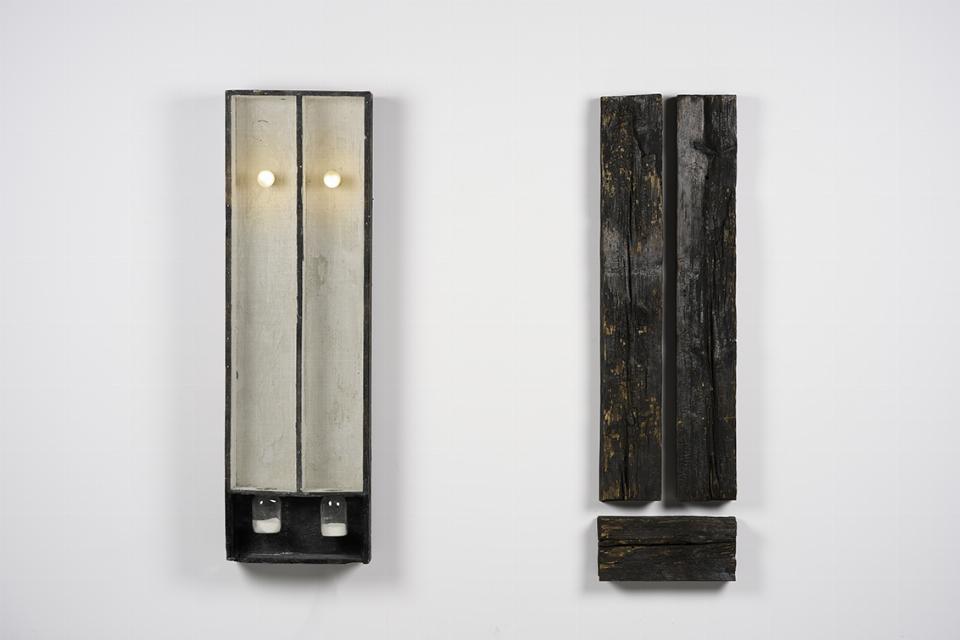Krzysztof Bednarski
Place for two I and II
Krzysztof Bednarski, Miejsce dla dwojga I [A Place for Two I], 1992, scorched wood, wire mesh, two glass vessels, pigment, 167 × 51 × 23 cm
Collection II of the Arsenal Gallery in Białystok. Work purchased by the Arsenal Gallery

The objects A Place for Two I and A Place for Two II constituted elements of Dark Passage II, a complex spatial installation constructed by Krzysztof Bednarski at Arsenal Gallery in 1993. It belonged to the larger cycle of installations, at the source of which lay the experience linked with the creation of Moby Dick (1987), one of breakthrough works in the artist’s oeuvre. Bednarski created the passages, to which Sun Passage of 1995 is a closure, in the course of a few years, making use of recurrent elements: lace doilies arranged in various configurations, a steel table, red and blue light bulbs, jars or boughs. Dark Passage II was dominated by objects similar to shelving, cupboards or showcases, which referred to the domestic, mundane and private sphere.
The object A Place for Two I is constructed to resemble an elongated cupboard with three recesses, two of them vertical, light-coloured, screened with dense wire mesh, and underneath them the third, horizontal, scorched. In the upper part of each vertical recess there is a white-light bulb; openings have been drilled in the bottom side. Two jars filled with white pigment are suspended inside the horizontal recess. Three sections of the object communicate through the openings: the inward light flows down from the vertical elements to the horizontal one, materialising on the white pigment. A Place for Two II, in turn, is an object similar to the previous one in shape; it is constructed of three scorched logs placed in an identical arrangement, and thus constitutes a negative image to A Place for Two I. Interdependencies between these two objects reflect the relationships found in Dark Passage II: the logic of mirror images, repetitions, positive/negative views, the symmetry of meanings and forms. Both Places are lodged in the complex web of meanings and messages referring to the artist’s personal mythology, memories of home and childhood. The passages are transitions, metamorphoses, alterations that occur in the macrocosm of the installation and microcosm of the object. The concept of transformation inscribed in objects, in connection with the stratum of the artist’s private experience, makes it difficult to interpret particular elements of the passages – the access code imposed by Bednarski is hard to break.
On the other hand, both Places for Two may also be perceived as elements of the all-embracing world of objects that surrounds us – objects which have their own biographies, structures, their external (social) and inner (personal) lives. Bednarski utilises such otherwise primary materials as wood, metal, light and pigment. The French sociologist Jean Baudrillard justly noted that wood derives its life from earth, it breathes, labours and grows old, it has its own scent and inner warmth. It is thus a matter/material characterised by its own kind of existence. Similarly light, with its numerous symbolic associations, in Bednarski’s work is seemingly transformed into pure matter as it falls onto a glass vessel. Objects constructed by Bednarski function in a web of primal, archetypal references that direct our associations towards fundamental questions about the essence of life, the logic of the world, the path of existence and its accompanying rites of passage.
Izabela Kopania
translated from Polish by Klaudyna Michałowicz

photo Jan Szewczyk

photo Jan Szewczyk

photo Jan Szewczyk

photo Jan Szewczyk

photo Jan Szewczyk

PLAN YOUR VISIT
Opening times:
Thuesday – Sunday
10:00-18:00
Last admission
to exhibition is at:
17.30